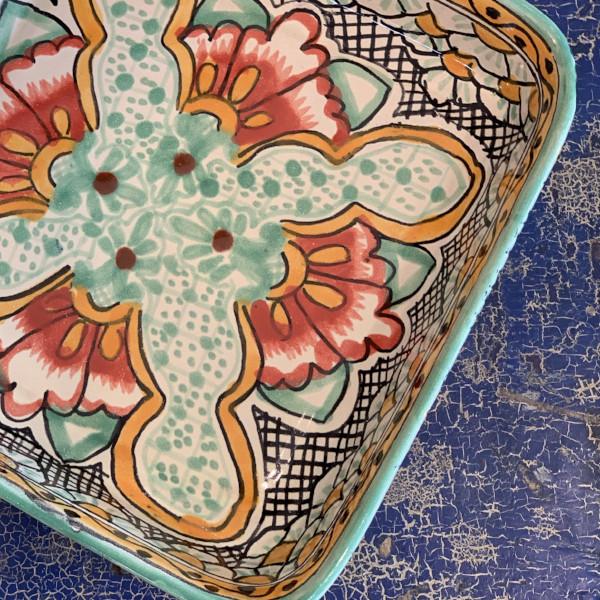
On my most recent buying trip to Mexico I visited Michoacán, a very large state west of Mexico City, home to the beautiful monarch butterfly winter destination, home to the colonial city of Morelia and home to many, many wonderful Mexican folk artisans.
We sometimes hear about Michoacán in the US and not favorably. This is what the U.S. State Department says about it:
"Michoacán: Morelia is a major city/travel destination in Michoacán - Defer non-essential travel to the state of Michoacán except the cities of Morelia and Lázaro Cardenas and the area north of federal toll road 15D, where you should exercise caution. U.S. government employees are prohibited from traveling by land in Michoacán except on federal toll road 15D during daylight hours. Flying into Morelia and Lázaro Cardenas is the recommended method of travel. Attacks on Mexican government officials, law enforcement and military personnel, and other incidents of organized crime-related violence, have occurred throughout Michoacán. Armed members of some self-defense groups maintain roadblocks and, although not considered hostile to foreigners or tourists, are suspicious of outsiders and should be considered volatile and unpredictable. Some self-defense groups in Michoacán are reputed to be linked to organized crime.
Many people have read the State Department notices or the horrifying stories about the drug cartels of Mexico and express their concern for me when I travel to Mexico. But I have found it to be true that no one I've encountered has been overtly dangerous. I have no fear in flying into Mexico City, staying in Mexico City, walking 10,000+ steps/day, taking taxis, buses and the subway and then taking a bus to somewhere where folk art is made, to visit artisans, and explore one of the most interesting countries in the world. I am careful, just like I am careful in the United States--aware of my surroundings, knowledgeable about the locations I visit and I try not to do dumb things.
On my most recent trip, I stayed overnight in Mexico City for a few days then took a bus to Morelia and stayed downtown in the Centro Historico. The closest I've ever come to violence in Mexico occurred behind the door of this lovely building in Morelia. I took this photo in the early morning before the shop had opened and made a mental note to return a little later in the day. So my friend and I returned and rang the doorbell which said, "Ring doorbell to see Mexican folk art." An older woman came to the gated entrance and asked what we wanted. I explained that I'd seen the sign and did she have "artes michoacanas" for sale? "Oh yes, come in." So, she immediately launched into a long and circuitous lecture about the macque work of Uruapan and the differences between macque and laca (DO NOT call it laca, she almost yelled.) I am familiar with the differences but she was really getting into describing every step, explaining in Spanish each step of the process from wood tray to finished product. After about 20 minutes of non-stop lecture (don't try to ask a question), my friend said, "Anne, we need to leave to go to our appointment" meaning to meet the taxista who was picking us up to go to Patzcuaro. This simple statement released an EXPLOSION of English--"GET OUT. GET OUT. ALL YOU AMERICANS WANT TO DO IS TO GO SHOPPING. GET OUT." We were stunned! We couldn't leave fast enough!

Fortunately, we'd taken an earlier, more relaxing, trip that day to the Casa de Artesanias, where there were many clay pineapples from Sante Fe Laguna. I purchased several of different sizes and color combinations.
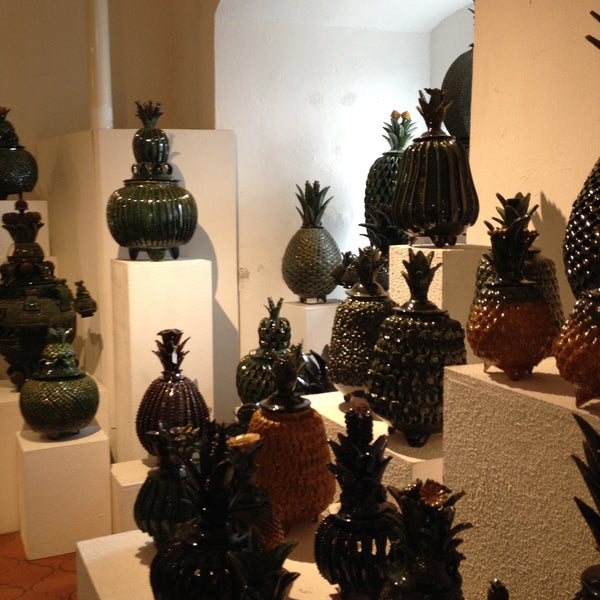
Next was a taxi to drive us and all of my boxes/packages to the charming small town of Patzcuaro.
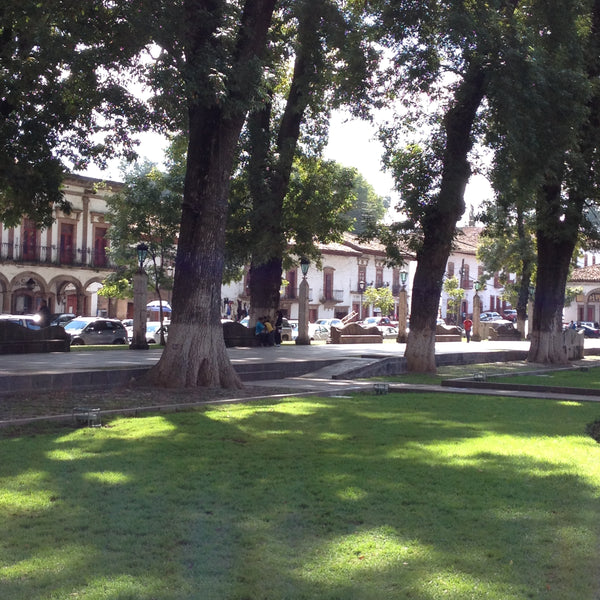
I took the photo above in the early morning on my way to the bank ATM before heading out to Capula to look for unique Day of the Dead folk art. I have never had any trouble of any type in Michoacán (except being yelled at for GOING SHOPPING) and I continue to want to go there to support and buy from the artisans who have seen a decline in the number of tourists and visitors over the last few years due to both the recession and the constant negative news about Mexico in the American press. On my most recent visit I saw evidence of a Patzcuaro revival--buildings being remodeled, new shops and restaurants moving in, folk art from farther away destinations like Chiapas, and even a few more visitors, though I think I only saw about 4 or 5 other Americans.
Capula was having its annual Festival of Santiago and I just happened to be there the day of the "Concurso" or the Fonart Sponsored Competition. I was fortunate to purchase four beautiful ceramic pieces that were in the competition. Watch for them in the next few weeks after my shipment arrives!
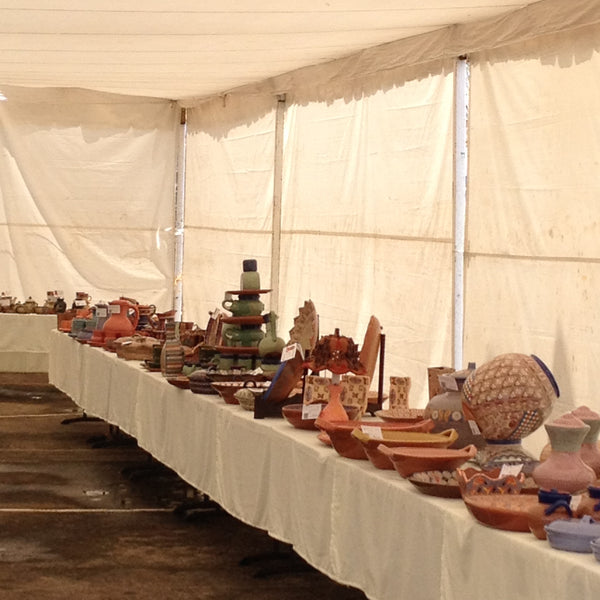
It's always fun to stop in Tzintzantzun on the way and look for treasures...
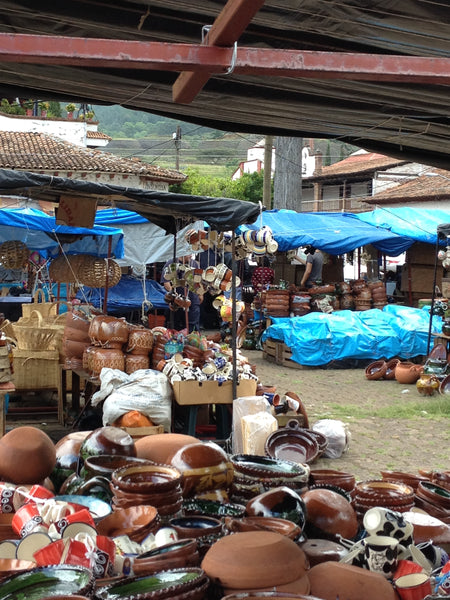
And Capula did not disappoint but I forgot to take photos of any of the purchases (sorry!) so you'll have to watch the website to see the Catrinas, skeletons, skulls and lots of other Day of the Dead purchases after they get here, are unpacked and photographed for the website!
For those of you considering a trip to Patzcuaro, I've stayed three times at Hotel Casa Encantada and highly recommend the location, the food, the rooms and the staff (hi Luis!). And they offer discounts during the low season of summer. What's not to like?

One other slightly harrowing adventure was having to drive all over Patzcuaro to find an exit road that was not blocked by residents whose water had been turned off! Apparently the local government had not paid the water bill and the water was turned off. So citizen protesters blocked all entrance and exit roads to Patzcuaro (only until 3pm said our taxi driver because people get hungry and go home to eat) and we got caught in that snarl for a little while. Mexico is always an adventure!

